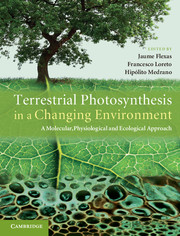 Terrestrial Photosynthesis in a Changing Environment
Terrestrial Photosynthesis in a Changing Environment Book contents
- Frontmatter
- Contents
- List of contributors
- Preface
- Acknowledgements
- List of abbreviations
- 1 Terrestrial photosynthesis in a changing environment
- Part I Photosynthesis
- Part II Measuring photosynthesis
- Part III Photosynthetic response to single environmental factors
- Part IV Photosynthesis in time
- Part V Photosynthesis in space
- Part VI Photosynthesis in a global context
- References
- Index
1 - Terrestrial photosynthesis in a changing environment
Published online by Cambridge University Press: 05 March 2013
- Frontmatter
- Contents
- List of contributors
- Preface
- Acknowledgements
- List of abbreviations
- 1 Terrestrial photosynthesis in a changing environment
- Part I Photosynthesis
- Part II Measuring photosynthesis
- Part III Photosynthetic response to single environmental factors
- Part IV Photosynthesis in time
- Part V Photosynthesis in space
- Part VI Photosynthesis in a global context
- References
- Index
Summary
Historical Perspective
The study of plant physiological responses to the environment (i.e., ‘ecophysiology’) has attracted researchers since early times, starting from Hales’ proposal that plants took their nourishment from the surrounding air (Hales, 1727), through Charles Darwin’s observations on leaf and chloroplast movements in response to external conditions and experimental manipulations (Darwin, 1881a,b; 1882), to Darwin’s son Francis’ early works on the relationship between transpiration and stomatal aperture (Darwin and Pertz, 1911; Darwin, 1916). From its very early re-foundations in modern times, plant ecophysiology has focused on photosynthesis – and transpiration, its undissociable process in terrestrial environments – as the most central physiological characteristic of plants changing in response to the environment. In parallel, considerable progress in the structural and biochemical basis of photosynthesis enabled improvement in the understanding of photosynthetic processes (Calvin and Benson, 1948), the integration of photosynthesis with transpiration and respiration and the view of photosynthesis as the basis for quantitative models of plant growth and crop production. Monsi and Saeki (1953) developed a theoretical frame to describe the distribution of light within plant communities, as Gaastra (1959) worked on photosynthesis in terms of gas exchange along a series of resistances in and out of leaves. Studies on leaf energy balance were initiated (Raschke, 1956; Gates, 1962) and later developed (Monteith, 1973), when portable infrared (IR) gas analysers for measuring photosynthesis became available (Bosian, 1960), allowing field campaigns of measuring photosynthesis in natural environments around the globe (Tranquilini, 1957; Lange et al., 1969; Björkman et al., 1972; Billings, 1973). In the late sixties and early seventies, the C4 pathway was discovered (Hatch and Slack, 1966) as well as the oxygenase activity of ribulose-1,5-bisphosphate carboxylase/oxygenase (Rubisco) (Ogren and Bowes, 1971), revealing a greater diversity of photosynthetic pathways than thought. Meanwhile, photosynthesis-based plant growth models were developed (Brouwer and de Wit, 1969; Penning de Vries et al. 1974). In the late seventies, an optimisation-theory model to explain stomatal behaviour linking photosynthesis to transpiration was developed by Cowan and Farquhar (1977), and the most widely used leaf photosynthesis model was presented (Farquhar et al., 1980a). After those decades, the importance of photosynthesis and related processes (such as transpiration, respiration and growth) was such that, according to several authors, plant ecophysiology in the eighties was fully focused on photosynthesis-related subjects, such as energy and mass exchange (Mooney et al., 1987; DeLucia et al., 2001; see Fig. 1.1).
- Type
- Chapter
- Information
- Terrestrial Photosynthesis in a Changing EnvironmentA Molecular, Physiological, and Ecological Approach, pp. 1 - 6Publisher: Cambridge University PressPrint publication year: 2012
- 1
- Cited by


